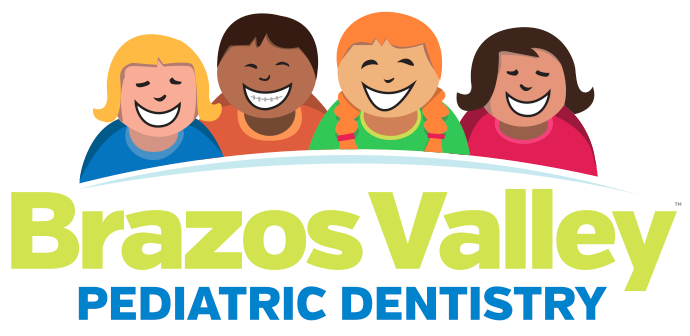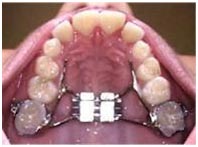ARCH WIRE
The part of your braces which actually moves the teeth. The arch wire is attached to the brackets by small elastic donuts or ligature wires. Arch Wires are changed and adjusted throughout the treatment. Each change brings you closer to the ideal tooth position.
BRACKETS
Brackets are the “Braces” or small attachments that are bonded directly to the tooth surface. The brackets are the part of your braces to which the dentist or assistant attaches the arch wire.
Occasionally, a bracket may come loose and become an irritation to your mouth. You can remove the loose bracket and save it in an envelope to bring to the office. Call the office as soon as possible and make an appointment to re-glue the bracket.
BAND & LOOP (B&L)
A Band & Loop is routinely used to hold space for a missing primary (baby) posterior (back) tooth until the permanent tooth can grown in.
ELASTICS
(RUBBER BANDS)
At some time during treatment, it will be necessary to wear elastics to coordinate the upper and lower teeth and perfect the bite. Once teeth begin to move in response to elastics, they move rapidly and comfortably. If elastics (rubber bands) are worn intermittently, they will continually “shock” the teeth and cause more soreness. When elastics are worn one day and left off the next, treatment slows to a standstill or stops. Sore teeth between appointments usually indicate improper wear of headgear or elastics or inadequate hygiene. Wear your elastics correctly, attaching them as you were told. Wear elastics all the time, unless otherwise directed. Take your elastics off while brushing. Change elastics as directed, usually once a day.
FUNCTIONAL APPLIANCES
These are used to help modify the growth of the jaws in children. The theory behind their action is that if you hold a jaw in a specific position long enough, that it will grow into that position. What you usually get is a combination of a little jaw growth with a lot of tooth movement. These are not universally accepted, as they do not always work.
The first of these appliances were removable and are still used by a few orthodontists. They are made of plastic and wire. Some of their names are Frankel, Bionator, and Twin-block. A different style is actually fixed to the teeth and uses a spring action to hold the jaw into position. These have names like Herbst and Jasper Jumper.
The headgear is used to correct a protrusion of the upper or lower jaw. It works by inhibiting the upper jaw from growing forward, or the downward growth of the upper jaw or even by encouraging teeth to move forward, if that is the case. Headgears are very popular in orthodontics because they give excellent results. They are worn at home while sleeping at night. Patients can get extra hours and thereby speed up their treatment by wearing their headgear while inside doing homework, reading, watching TV, etc. The changes from good headgear wear are very permanent and stable.
HEADGEAR
LOWER LINGUAL ARCH (LLA)
A lower lingual arch is a space maintainer for the lower teeth. It maintains the molars where they are, it does not move them. This is fabricated by placing bands on the molars and connecting them to a wire that fits up against the inside of the lower teeth. It keeps the molars from migrating forward and prevents them from blocking off the space of teeth that develop later. This is used when you have the early loss of baby teeth or when you have lower teeth that are slightly crowded in a growing child and you do not want to remove any permanent teeth to correct the crowding.
Poor positioning of the teeth.
MALOCCLUSION
TYPES OF MALOCCLUSION
Class I
A Malocclusion where the bite is OK (top and bottom teeth align) but the teeth are crooked, crowded or turned.
Class II
A Malocclusion where the upper teeth stick out past the lower teeth. This is also called an “overbite.”
Class III
A Malocclusion where the lower teeth stick out past the upper teeth. This is also called an “underbite.”
OCCLUSION
The alignment and spacing of your upper and lower teeth when you bite down.
TYPES OF OCCLUSION
Openbite
Anterior opening between upper and lower teeth.
Overbite
Vertical overlapping of the upper teeth over the lower.
Overjet
Horizontal projection of the upper teeth beyond the lower
Crossbite
When top teeth bite inside the lower teeth. It can occur with the front teeth or back teeth.
O RINGS
O rings, also called A-lastics, are little rings used to attach the arch wire to the brackets. These rings come in standard gray or clear, but also come in a wide variety of colors to make braces more fun. A-lastics are changed at most every appointment to maintain good attachment of the arch wire to the bracket, enabling our patients to enjoy many different color schemes throughout treatment.
PALATAL EXPANDER
An appliance which is placed in the roof of the mouth to widen the upper dental arch. In children the maxilla, or upper dental arch, is joined in the center by a joint, which allows it to be painlessly separated and spread. Temporarily you may see a space develop between the upper two front teeth. This will slowly go away in a few days. Once this has occurred, the two halves knit back together and new bone fills in the space.
Care of appliance: Brush as usual. Brush the appliance and roof of the mouth thoroughly. Rinse often to clean any food lodged between the arch and appliance.
RETAINERS
At the completion of the active phase of orthodontic treatment, braces are removed and removable appliances called retainers are placed. To retain means to hold. Teeth must be retained or held in their new positions while the tissues, meaning the bone, elastic membranes around the roots, the gums, tongue and lips have adapted themselves to the new tooth positions. Teeth can move if they are not retained. It is extremely important to wear your retainers as directed!
SEPARATOR
A plastic or rubber donut piece which the dentist uses to create space between your teeth for bands.












